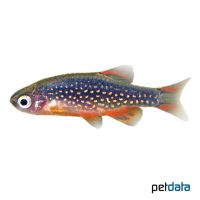Galaxy Rasbora (Danio margaritatus)
| Galaxy Rasbora Danio margaritatus | |
|---|---|
| Name | Galaxy Rasbora |
| Name Lat. | Danio margaritatus |
| Synonym | Celestichthys margaritatus |
| Family | Danios |
| Family lat. | Danionidae |
| Order | Carps |
| Order lat. | Cypriniformes |
| Origin | Southeast Asia |
| Habitat | Stagnant water bodies |
| Diet | Omnivore |
| pH | 6.0-7.5 |
| Behavior | Peaceful |
| Keeping | Swarm |
| Care Level | Moderate |
| Reproduction | Egg scatterer |
| Breeding | Moderately difficult |
| Life Span | 2-3 years |
| Protection | No |
| Metric Units | |
| Size | 2 cm |
| Temperature | 20-26 °C |
| Hardness | 5-15 °dH |
| Aquarium | 60 cm / 54 l |
| US Units | |
| Size | 0.8" |
| Temperature | 68-79 °F |
| Hardness | 89-267 ppm |
| Aquarium | 15 gal |
Distribution and habitat
The distribution area of the guinea fowl danios is in Shan State in eastern Myanmar. There they live in the shallow, only about 30 cm deep water of ponds and permanently flooded meadows with dense underwater vegetation.
Maintenance
The aquarium should have very dense planting (hiding and retreat possibilities). A dark substrate, shaded light (floating plants), hardly any current and neutral to slightly alkaline water is ideal
No ammonia, ammonium and nitrite should be detectable, the nitrate value should not exceed 100 mg/l. To ensure the water quality and oxygen content, a filter and heater adapted to the aquarium size is required, as well as lighting for the species-appropriate day-night rhythm of the animals.
Diet
In nature they feed on insects, small crustaceans, zooplankton and algae. The food supply consists of live, frozen and dry food. For a balanced diet, feed once a day with a high-quality dry food (flakes, granules, pellets) as well as cyclops, daphnia or artemia (live or frozen). In addition, they need regular vegetable food, such as pureed leafy and wild vegetables, algae leaves or dry food with vegetable ingredients (e.g. spirulina).
Only feed as much as will be eaten within a few minutes. A regular and varied diet promotes health and prevents deficiency symptoms.
Behaviour and compatibility
They are shy, peaceful schooling fish and can be socialized well with other small, not too lively and peaceful fish. In groups that are too small, the males behave aggressively within the species. At least 10, but preferably much more guinea fowl should be kept together.
Basically, only compatible fish species with similar demands on water quality and water temperature should be socialized.
Sex dimorphism
The males are more intensely colored, have red fins, and are more slender than the plumper females, whose fins are transparent to orange
Reproduction and breeding
They are free spawners that do not engage in brood care. The male swims around (drifts) the female, which spawns among fine-feathered plants. The larvae hatch after about 72 hours and swim freely after 3-4 days.
Fry must be fed several times a day with special rearing food (Artemia nauplii). In community tanks breeding is hardly possible, because the spawn is easy prey
Important
The well-being of the fish should be checked regularly. The temperature should be checked daily, the pH, hardness and nitrate value at least every 14 days. A regular partial water change is recommended, even if the pollutant load has not yet reached the upper limit. Sudden changes in water quality should be avoided. Newly introduced fish must be accustomed slowly to the water in the aquarium.
Further literature can be found in your pet store.
References
Text: Werner Winter; Image: petdata
Source: BMELV (1998): Tierschutzgutachten - Haltung von Zierfischen (Süßwasser); ENGELMANN (2005): Zootierhaltung - Tiere in menschlicher Obhut: Fische, Verlag Harri Deutsch
- Gemäß § 21 Abs. 5 Tierschutzgesetz idgF
